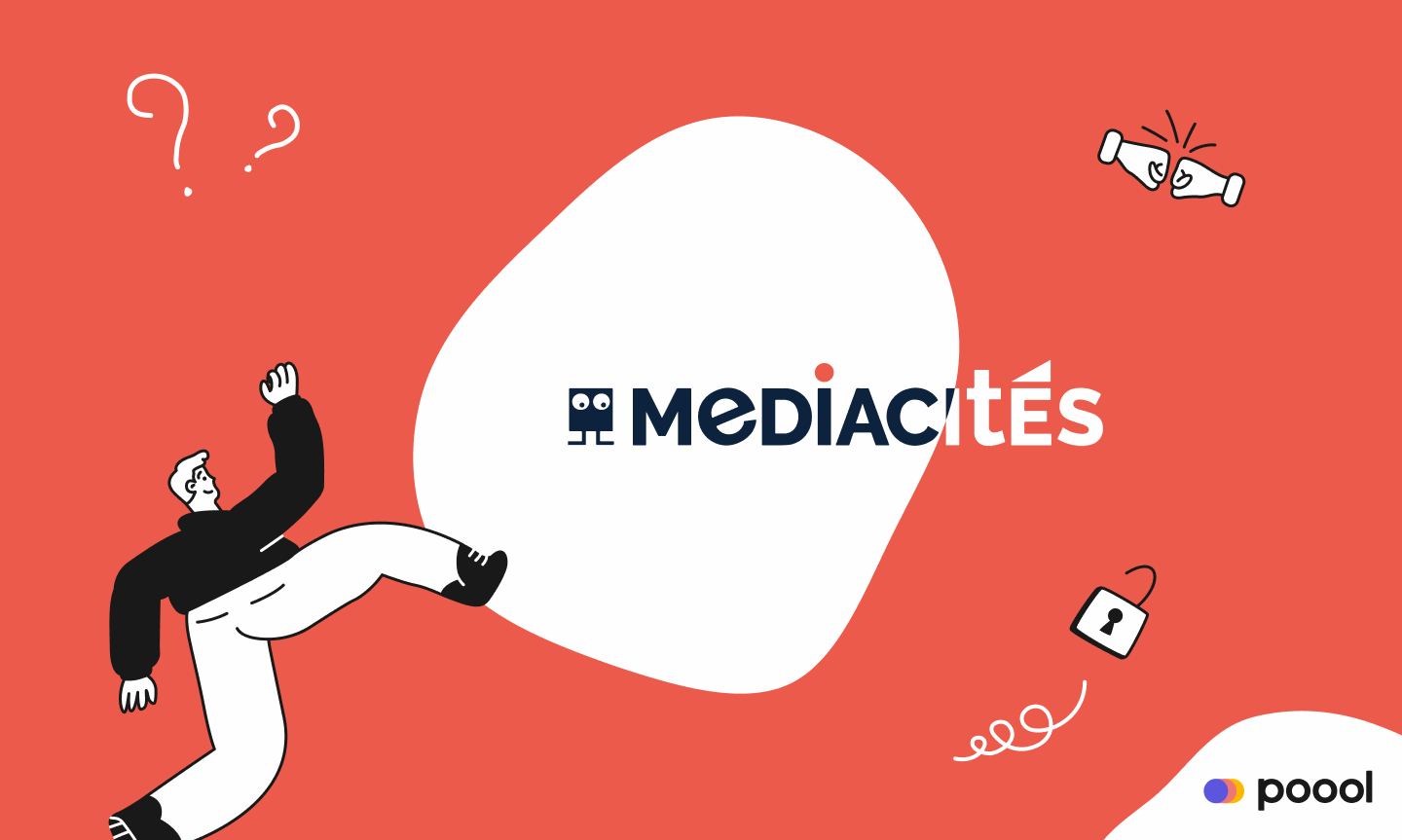It's easy to assume that our dynamic solution can only be used to integrate a paywall into your site. However, this is far from the truth! In fact, our mission is to provide a product that is entirely adaptable to your business goals and strategy, which is why Poool Access allows you to integrate a wide variety of walls into your user journeys (and of course segment your audience to present each grouping with adapted experiences) - registration walls, newsletter walls, survey walls, ad walls and more...
Poool Access is an all-in-one solution, allowing you to employ any wall type, combine walls, test out different user journeys and more, all from your own Dashboard control center and without any need for tech support.
That's why we're here today to show you the endless possibilities of Poool's solution, with client examples and success stories to support our claims.
Before we start, remember that you can segment your audiences and build adapted journeys for each segment, made up of a combination of walls. So, although this article will mainly discuss walls one by one, they can be employed consecutively within a user's journey.
For example, a volatile user who has a low propensity to subscribe could be presented with a newsletter wall, followed by a registration wall and then finally a paywall. These soft conversion walls allow the user to become increasingly engaged with your content so that, when they reach the paywall, they're highly more likely to subscribe.
To create this journey, we simply move the 'Widgets' (from the list on the right) into the order that we desire, configuring each to match our branding and strategy.

(Note that the 'Form' widget in this user journey is a registration wall - we simply make this form into a registration wall in the 'Forms' section of the Dashboard and configure what information we want to ask from the user, such as name, email address, etc.)
Registration Wall

By moving the 'Form' widget into a scenario, we can add a registration wall into a journey to ask or require users to create a free account in order to access content.
As with all widgets, we're able to modify every aspect of the wall in the Dashboard, including design, wording and the form fields that the user needs to fill out. Below, for example, we configured the form to require only the user's email address (on the left) and then can see the result in the scenario (on the right).

Boursier employs a metered registration wall where users are able to access 4 articles for free before they're faced with the registration wall. They achieved this by adding 4 'Invisible unlock' widgets into the user journey before requiring registration.

A registration wall is a hugely beneficial soft conversion that can be employed alone or as part of a subscription strategy:
- Collect first-party data (email addresses in particular) to inform your strategy
- Improve your audience's experience by encouraging registration and personalizing their account space, such as by recommending content, targeting ads or allowing content to be saved for later
- Increase ad-based revenue with targeting thanks to your data collecting
- Turn an unknown user into a lead who can be nurtured and better sold subscriptions or products in the future
- Boost engagement (which is essential for increasing propensity to subscribe, conversion rates, retention rates and, ultimately maximizing revenue)
Newsletter wall
It's pretty self explanatory but this wall asks or requires users to sign up to your newsletter in order to access content.
Just like the registration wall, this is achieved via the 'Form' widget by adapting the form fields and text. Euronews, for example, has very effectively integrated newsletter walls into their user journeys, with the useful possibility of being able to use the Dashboard to alter the language used based on which site the user is accessing (i.e. euronews.fr, euronews.es, etc.).

Newsletters have made a come back over recent years amongst content creators and for good reason:
- Increase engagement by sending content directly to their inbox
- Form habits (the secret to increasing frequency of visits, engagement, conversions and retention rates)
- Personalize content thanks to a variety of newsletters covering different topics and allowing users to register for those that interest them the most
- They establish a direct link to your users and build a strong and lasting relationship with them
- And (because of all of the above) increase your user's propensity to subscribe
The table below highlights how increased visits and being a recipient of the newsletter or account holder makes a user more likely to convert into a subscriber.
Given all this, it's perhaps no surprise that The New York Times has seen such success in their digital subscription strategy, considering that they publish 50 newsletters with over 15 million users reading at least one of these every week, according to Digiday.
Donation Wall
So far, the walls have primarily had the goal of increasing engagement in order to monetize in the future from the user converting to a subscriber. However, we can also employ walls that directly monetize your audience in a way that isn't a paywall.
A donation wall allows users to support the production of content without having to commit to a recurring subscription payment and with the choice of how much they can afford to donate. Le Petit Journal, for example, employs a donation model to monetize their audience whilst continuing to provide free, independent journalism available to everyone.
LPJ have made donating optional on their site by employing the 'Suggested subscription' widget and adapting the wall's wording to ask for a donation instead of subscription. If a user clicks on 'No thank you' (Non, merci), they'll later be presented with a registration wall to create a different form of value exchange.

To find out more about donation models for content producers, take a look at our dedicated article:

Survey Wall
There's so much other value that you can exchange with your audience using a wall aside from monetary value. A survey wall is a great demonstration of this, allowing you to ask users to answer a question in exchange for access to content.
On the Dashboard, you can create any survey that you desire, ensuring that you collect data from your audience that's going to be valuable for your business and decision making. For example, Mediacités decided to employ a survey wall with users who had previously been presented with the paywall on multiple occasions, asking them the reason why they chose not to subscribe. Information collected could then be used to inform their wall strategy, optimizing subscription offers to make them more attractive to their audience.

We have a dedicated 'Survey' section in the Dashboard where you can configure the question and multiple choice options, of course also being able to change the design in the 'Appearance' section as usual. Then, all that's needed is to move the survey widget into a user journey, selecting which survey you'd like to use, set live and results will be sent directly back to your Dashboard.

Read more about Mediacités in their success story on our blog!

Ad Wall
How about using a wall to increase your ad-based revenue? Well, with an ad wall, you can ask users to watch a short video advertisement in exchange for access to content. This is thanks to our Viewpay connectors, available as an ad wall widget for all of our clients.
Challenges makes full use of this feature, integrating 3 ad walls in a row within a journey (enabling a user to access 3 articles for free in exchange for watching these ads) before they're presented with a newsletter wall.

This allows Challenges to monetize from advertising whilst simultaneously engaging their audience with free content before leading them to a soft conversion (newsletter sign up and later registration) before the paywall. Importantly, a strategy such as this means that the publisher can monetize from all users, not just subscribers, but without sabotaging their overhanging goal of converting their audience into a paying subscriber.
There's often a concern amongst content producers who come to Poool that integrating a wall into their site will negatively impact ad-based revenues. However, this is far from the case (take a look at JDD and Boursier's success stories) and a wall can in fact boost monetization from advertising when employed in the right way.
Interested in hearing about how we can help you integrate a wall into your site (or optimize your current one) without affecting other revenue streams, engagement or traffic on your site? Book a free demo and meeting to chat with our team!
Paywall
Finally, the wall you know all too well. But, don't jump the gun - our paywall does more than the static, hard paywalls that online consumers fear. We do things a bit differently, which has allowed our clients to significantly increase conversion rates, boost engagement and ultimately better monetize their audience.
We're sure you're aware of what a paywall does, but, in short, it asks or requires a user to pay to subscribe in order to access content. (Read more about paywalls in our dedicated article).

So what makes our paywall different? Well, it's dynamic.
This means you can segment your audience based on a user's profile or context (such as content type, device used, location or propensity to subscribe) and build adapted experiences for each of these segments.
For instance, Libération and La Croix International both make use of this to optimize CTR and conversion rates. Libération segments their user's based on their location and adapts wording to personalize the wall, with this example being presented to someone in Switzerland. La Croix on the other hand employs a different user journey depending on whether they're access the site on desktop or mobile. For mobile users, they're offered an article for free before facing a hard newsletter wall, whilst desktop users will be directly presented with the newsletter wall.

We have custom segments already set up based on a user's level of engagement that you can use alone or integrate into another segmentation (e.g. users in Spain as the first segmentation, which is then further segmented into these native groups - volatile, occasionals, regulars and fans).
To add to this, your marketing teams also have full autonomy to configure, carry out and analyze A/B tests within each individual user segment. This allows you to find the user journey, design and wording that results in the maximum number of conversions, meaning you can continuously optimize your walls for success.
ELLE.fr, who normally employs the yellow wall below, decided to A/B test an alternative design over summer, altering the image, placement and forefronting of their offer (€1 for 2 months) as well as the colors used, with the goal of increasing CTR. After launching the test and analyzing results in the Dashboard, they found a 2 times increase in CTR for the summer version compared to their normal paywall, allowing them to adapt their strategy and walls based on these findings.

And, if all this wasn't enough, our solution also allows you to integrate payment directly into the wall itself thanks to Stripe! Facilitate the subscription process and reduce steps in the funnel to increase conversion rates by simply creating a form with a Stripe field and integrate it into your user's journey. Achieved in 5 minutes and not a tech team in sight.


A cookie wall is slightly different to any other walls that you can employ with Poool.
When a user arrives on your website, they'll need to be asked if they consent to cookies and tracking with a consent banner. Of course, it's beneficial to you if the user accepts cookies, but with consent rates declining rapidly and online privacy restrictions tightening (which isn't a bad thing at all), publishers need to start finding a cookie-free alternative that allows a user to support the production of your content in a different way. This is exactly what a cookie wall does - it's presented to a user who's declined cookies and tracking, offering another, cookie-free way for them to access your content.
The alternative could be subscribing, paying a one time fee, creating a free account or something else, but, importantly, it must not involved cookies or tracking in order for it to abide by legal privacy regulations.
This wall therefore allows you to respect your audience's privacy and monetize your content simultaneously.
Overall, Poool Access is an all-in-one dynamic wall solution, which allows you to integrate walls into your segmented audience journeys that match your strategy and achieve your goals.
👉 Under 2 days of tech integration
👉 Full autonomy for your marketing teams via the Dashboard
👉 Launched on your site in a matter of days
👉 Employ a hard, metered or freemium strategy (or combine them!)
👉 ROI in an average of 30-60 days amongst our clients
👉 Ability to integrate any wall type and combine walls into user segments
👉 Test, analyze and optimize as much as you'd like, forever
Interested in trialling the Dashboard out for yourself? Book a free demo and meeting with our team to hear about Poool will help you achieve your goals!



